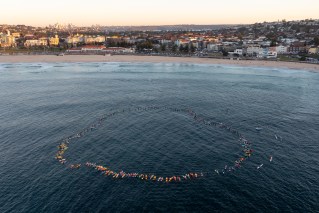NSW and Queensland are set for months of wet weather as authorities issue new flood warnings

Exhausted residents are in “disbelief” as evacuation orders were issued late Monday for parts of north and south Lismore and low-lying areas of Kyogle ahead of predicted torrential rain and “life-threatening” flooding.
Locals were told to leave by 10pm on Monday amid fears that NSW’s already-soaked northern rivers region could get up to 140 millimetres of rain in six hours, and up to 200 millimetres in some isolated falls.
The epicentre of unprecedented floods last month – still in the midst of a mammoth clean-up – is on the frontline, along with Tweed Heads, Evans Head and Yamba, as well as Grafton and Coffs Harbour.
“Everyone is a bit shell-shocked, they’re in disbelief, they’re exhausted … and others are frantically trying to prepare the best they can,” Lismore councillor Adam Guise said.
“It’s all a bit uncertain and people are pretty devastated and scared facing the prospects of another major flood.”
The weather bureau said there were severe weather warnings from the Queensland border to Coffs Harbour, spanning 450 kilometres of coastline.
Meteorologists say people on the east coast should brace for weeks, or even months, of wet weather.
Jane Bunn, a 7News meteorologist and founder of JanesWeather.com, said a low-pressure system had triggered the latest rain, on top of already very moist conditions.
“The low itself is going to track very slowly southwards, so by Wednesday, that puts south-east Queensland no longer in the danger zone because it’s too far north for it,” she told The New Daily.
“This low is just going to sit there for days, and days, and days. That’s what all the weather models have.”
In addition to expected flooding, other areas such as Sydney will experience rain for the foreseeable future.
“For Sydney and the south coast, those sort of areas, it’s not intense rain, but it’ll be just as we’ve been experiencing – day after day of wet weather coming in,” Ms Bunn said.
What’s causing the renewed flood warnings?
“La Niña is still the big player in this,” Ms Bunn said.
This global weather pattern has been responsible for the rainy conditions since the end of 2021.
However, a slow-moving low-pressure system off the coast of Queensland has triggered this latest bout of torrential rain and flood warnings.
“As part of that there are two other climate drivers that are helping bring that,” Ms Bunn added.
“One’s called the SAM [Southern Annular Mode] and the other one’s called the MJO [Madden-Julian Oscillation].”
This perfect storm of weather conditions encourages low-pressure troughs, thus intensifying the back-to-back days of rainfall.
Severe Weather Update: heavy rainfall and life-threatening flash flooding for SE Qld and NE NSW. Video current: 2.00pm AEDT 28 March 2022
Know your weather, know your risk. For the latest forecasts and warnings, go to our website https://t.co/NOCRPngsQY or the #BOMWeather app. pic.twitter.com/UT8kSPpu8l
— Bureau of Meteorology, Australia (@BOM_au) March 28, 2022
The conditions on the ground are also cause for concern.
That’s because many of the rivers in northern NSW still haven’t recovered from the last bout of torrential rainfall.
“Locally intense rainfall is possible and since many catchments are now saturated, there will be an increased risk of dangerous and life-threatening flash flooding and landslides during this event,” the Bureau of Meteorology said in its warning on Monday.
How long will the wet weather last?
Over the weekend, the Bureau of Meteorology warned that the broader wet weather conditions could last for months.
“In the longer term, so the next few months, there’s no real sign that it’s going to dry out along the coast, so I know that’s not great news,” BOM spokesperson Jane Golding said.
Ms Bunn added that La Niña “tends to break down at this time of year”, but noted this hasn’t happened yet.
“And this is a slow process, so the fact that we still have that big pile of cold water way out there in the middle of the Pacific Ocean means that it takes months to break down.”
This weather pattern will need to break in order for the wet weather to ease.
Current view from space with cloud over most of eastern #NSW. Chance of severe thunderstorms in the northeast today and tomorrow with heavy rain and locally intense rainfall possible, which could lead to life threatening flash flooding.
Monitor warnings: https://t.co/gXlDL5D4sd pic.twitter.com/bHV2bNjYMn— Bureau of Meteorology, New South Wales (@BOM_NSW) March 28, 2022
What’s in store for the rest of Australia?
The torrential rain forecast over the next couple of days will largely fall across northern NSW.
Additionally, the months of forecasted wet weather will largely affect the east coast.
Victoria, in general, has been spared from this wet weather for most of the year.
However, even when the effects of La Niña do wear off in a few months’ time, weather patterns over the Indian Ocean could bring moisture to southern parts of the country and continue the trend of wet weather.
“Queensland will probably take a bit of a break from that one, but in terms of Victoria, Tasmania, South Australia, parts of Western Australia, and also southern NSW, they can still get quite a bit of rain out of it,” Ms Bunn said.
But Sydneysiders with rain fatigue should not stress.
“With the Indian Ocean system, Sydney won’t get day after day after day of wet weather,” Ms Bunn said.
“When the rain system comes along, it won’t be like what we’ve seen over summer.”
-with AAP








